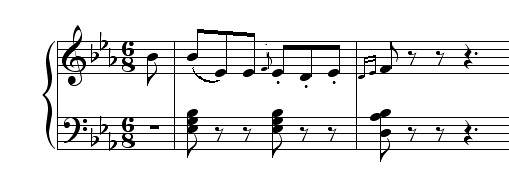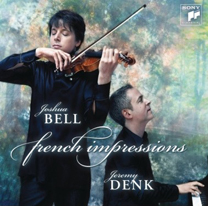The opening of the “Kegelstatt” trio is unusual: unusual enough that it obtained a (probably) spurious nickname. And yet, at the same time, there is nothing revolutionary in there. It is the usual classical bag o’tricks: dialectical, question-and-answer fragment-phrases, moving from tonic to dominant to tonic etc. etc. Then, predictably, there are two paired, longer phrases: one with a deceptive cadence, one with a full cadence … from the point of view of construction, there is absolute tedium, just Generic Structure, nothing to see. (And the more you describe it in these terms, the less you may see.)
The nickname “Kegelstatt” derives from something unusual in the material itself, not the phrase construction (though I mostly distrust distinctions between form and content). Here’s the famous motive …

… a strong tonic note (foundation), a turn (ornament, fancy), a downward arpeggio (tail, conclusion), also in the tonic. The bowling image is—whew!—not totally idiotic. It works, as would any metaphor with an initial attack or impulse, followed by a kind of helpless release: anything with consequences that fall away. These consequences are not willed, made, or manipulated; they are to be heard as “just” the result of the  first note, the result of musical physics.
first note, the result of musical physics.
An ornamented tonic arpeggio is really the most boring, conventional way to begin a classical work, or any work; why is this arpeggio special? If I think closely about what in the motive appeals to me, about how it “feels” to play it, when I am playing it well (IF I am ever playing it well), it has something to do with the downward passage of the four last notes, the sense of passing. It’s as if, while blowing, you pulled out a valve on a horn, smoothly, evenly, and the various notes of E-flat are touched on their way down, in a gliding motion. Though you hear the individual notes of the E-flat triad, what you feel is the smooth gliding of the valve.
One of the crucial aspects of Mozart’s exploration of our audible frequencies is his ability to imbue just a simple, expectable arpeggio with a special, sensual quality, a quality somewhat at odds with functionality. Of course, everything functions. Everything functions, in fact, as it should, in “textbook” fashion, even—your Theory Teacher can show you how it’s done but could never do it—with perfect, well-versed voice-leading (to say the least). This perfect functioning is a kind of innocence at the end of exhaustive knowledge. (Innocence figures prominently in Mozart’s iconography: Mozart the child genius, the gift from God, music written in heavenly script and only transcribed by its human conduit …) Every note, every motive, every moment can say: I’m “just” an arpeggio; or, I’m “just” the tonic headed to the dominant; I pass from here to there, filling this space … It shows its workings transparently; you can write flawless harmonic analyses till the cows come home. And yet against this innocence, I hear other qualities, unexpected searing beauties tucked away in the nooks and crannies of the tonal system, which rub against the grain of the tonal system even as they function within it. These sensual qualities (or “qualia” in philosophical speak) are the truly subversive parts: just the sound of a certain arpeggio framed a certain way; the timbre of an instrument coloring a particular voice; anything at all. The uniqueness of the moment finds a way to protest the generic tendencies of the construction. Beauty subverts functioning.
(This last sentence has been proven in my life 3,793,421 times; the last time was just yesterday, when Cory called me at 3 in the morning to explain that he was following two beautiful 18 year old girls, and had found himself inexplicably in their company at a McDonalds—McDonalds! I did not answer the phone but woke up nonetheless and then found myself stumbling over to my phone which was charging against the wall and listening to his voicemail and then sleeping very intermittently until 7 when I decided to get up once and for all, super grumpy. Cory, meanwhile had 7 hours of rehearsal and a 3 hour drive the next day, and when contacted by phone seemed a bit turgid or sluggish in temperament; I, too, found myself often staring at a sock on my floor, simultaneously langorous and bitter, and incapable of will. Thus, the beauty of the two girls—which I did not even witness!—passed, like a virus, through Cory to me and impeded both of our functionings. Astounding.)
This subversive beauty could be attributed to certain parameters: the octave G down to G, transected by two thirds and a fourth, a registral shift, also the fact that the chord is E-flat at the 1st inversion, the notes at the beginning and end are not “stable” notes … all of these factors sound like scientific indicators of “why” this moment, this motive has a certain quality. Only by playing the passage a number of times, by caressing these parameters, by exerting your imagination upon them in fits and starts, would you arrive at some cogent realization of its qualia for you: what it is, after all, you hear “in it.”
I said already, and let me lay heartless words upon heartless words: it has something to do for me with the relationships of the notes, with the instability of the Gs at either side of the arpeggio, the G passing down to its octave lower compatriot, neither of which a true stopping point, both of which provisional, but opening up a registral space, a triadic configuration, for contemplation.
“Opening up a triadic configuration” does not sound very beautiful, does it?
What does it open into? After the last pin falls, there is silence. The phrase fades, falls into four eighth notes of nothingness. It is in this silence, perhaps, that one truly “hears” the motive that was just played. Hmm. You can use that time to reflect on the qualia of the preceding notes, which we have just slavishly buried under a mountain of words.
The opening of this piece is, in fact, stacked heavily with silences; Mozart wants us to hear, rehear, expect, wait. (Our acts of hearing and waiting are “built into” the structure.) I said the piece begins by opening up a registral space; I might metaphorically extend that; it’s like the piece opens its mouth, as if to sing … The bowling motive “functions” (forgive me) as a kind of musical yawning … Yawning is suggestive, because once the jaw drops (G-Eb-Bb-G), nothing comes out … or, more precisely… you are waiting for something and (after a calculated, exasperating pause) what comes out is impish, courtly, flirtatious, a bit glib:
Charming: perhaps a bit funnier, lighter than you would have expected from the opening idea, but thereby playing the dialectical, paradoxical games of the classical style. This second idea also (like the first) closes with a kind of opening. Its concluding grace notes are wonderful, like a last-minute flip, a wondering and upturning smile. It would seem the piece is beginning to take shape. But after the smile, we have yet more silence; the measure goes by while the smile freezes upon your face.
By the time we hear the bowling motive again, if you’re not clueless, you have figured out that Mozart is positing a kind of peculiarly slow rhythm of happenings. Actually, the construction, the template, is fine. 2 bars and 2 bars, etcetera, etcetera. But the material is too short! It ends way before its time and we simply have to wait around till the arriving barline prompts us. Why would Mozart deliberately write material that does not fill the space?
Mozart’s no fan of extra effort. He does the simplest thing; he creates space in order to fill it, in order to reveal the miracle of continuity. He forces you to listen to the silences; this (slightly perverse) act then rebounds and makes you re-comprehend something you would normally take for granted: the line of a phrase. The clarinet appears and soars:
Harmonically, this is (again) nothing special, I-IV-V-I. You can pick it up by the bushelful at the Classical WalMart. What special quality, what qualia, does Mozart manage to affix to this most prosaic of constructions? Well, the answer is quite simple, sensual, basic: the continuity depends upon, our attention is drawn to, the breath of the clarinetist, a miracle (life itself). Mozart makes us hear breath. We had such long spaces for breath before, even: too much time to breathe, to get ready for the next phrase, a series of overlong pickups or misfired cues. All those breaths, those rests, those baited breaths, while fragmentary phrases waited for their futures … all of that just to hear the clarinetist breathe once, simply, out. The sing-song, the see-saw, the tit-for-tat, all condense into a singularity. Logic and dialectic give way to air.
Afterthought. The outlining notes of the clarinet melody are:

Sound familiar? It’s a transposed version of our earlier arpeggio:

… i.e. the “breathing-out” of the first phrase. If you think that this resemblance is a coincidence, you’re an idiot. (I’ve been watching too much House.) The short, quick exhale of the opening motive is magnified 6 times over; it becomes the tremendous redemptive descent of the new theme: a breath which finds its groove, its deeper meaning.
Actually, I lied. (Again, too much House.) The clarinet does not play the entire arpeggio. It plays the first three notes:

and then the piano “interrupts” it, takes the last note, stealing the clarinet’s destined conclusion:
(I love the silence there, the wicked sixteenth-note rest in the clarinet part, just at the last moment, the fulfilling moment.)
… and you didn’t believe me when I said timbre was subversive! Mozart has visited us again with functional, whispered, sweet-nothings. That chord is just plain yummy, partly because it is stolen; the pianist’s intervention here is an unexpected beauty, a joyous theft, coinciding with the deceptive cadence (harmonic deception=timbral deception) … a little zing, a bait-and-switch beneath the seamless perfection of the whole. It’s not the sort of thing you’d read about in any theory textbook, probably: it’s too dangerously like life, like the strange, hidden switches behind events, coursing coincidences, qualities or impulses that wake us up at 3 in the morning, and are endlessly hard to explain.






One Comment
Wow! I’m new to this blog and i’m already a fan. Where else can you find a thoughtful, humanist analysis of the K. 498 trio and its relationship to threesomes in a more, um, general sense?